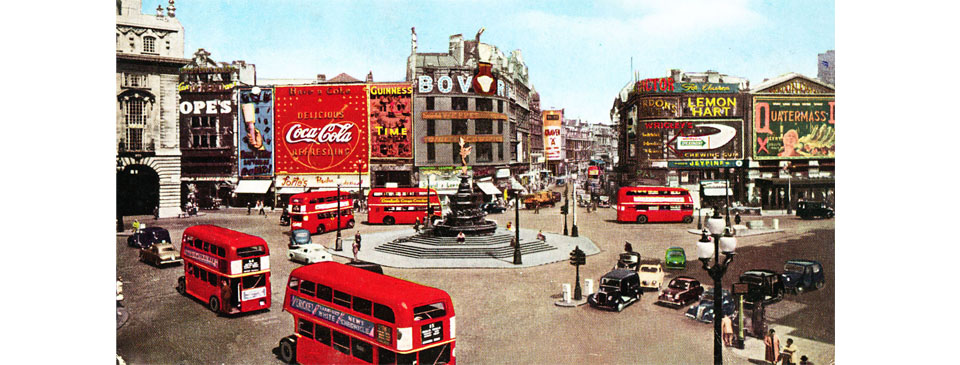In brief – Late-20th century London

Traffic flows around the Shaftesbury Memorial fountain at Piccadilly Circus in about 1955. The Bovril and Guinness advertisements had been in place for several decades when they were joined by Coca Cola shortly before this photo was taken. The film Quatermass Experiment is showing at the London Pavilion cinema.
From the second half of the 50s there was a growth in demand for offices in London due to the increase in office-based work and greater government bureaucracy. It was spurred on by a new generation of office developers who had become experts in locating suitable sites, finding architects, negotiating with the London County Council, and raising finance. At the same time the LCC were looking to modernize London with new kinds of architecture and to build new roads for the increasing traffic. If a developer could satisfy those requirements they had a good chance of receiving planning permission. In order to achieve the greatest return on investment from often relatively small pieces of land in Central London the developers needed to build tall multi-floor office blocks. Yet the government was worried that the growth in employment in London was at the expense of the rest of the country and they began to think about transferring civil service jobs to those areas where industry was in decline. From 1964 the Labour government made it extremely difficult to obtain permission for any new office developments in London, bringing a temporary halt to the office boom.
Much of London’s housing stock, particularly in the private, rented sector, was still wholly inadequate by modern standards. As late as the 1970s over half of all such accommodation lacked a private bathroom and many tenants shared a toilet. Post-war planners saw an almost unique opportunity to solve London’s chronic housing problems. Many of the bombed-out slum districts were transformed into new estates by the LCC and local councils during the 1950s and 60s and by local councils in the 1960s and 70s. By the last decade of the century only a tiny fraction of Londoners lived in accommodation without their own private bathroom and toilet.
Some of the new social housing developments included super-modern high-rise apartments, known as ‘tower blocks’, with floors reached by electronic lifts. However high-rise accommodation went out of favour during the latter 1960s, particularly when a gas explosion occurred at the Ronan Point building in Canning Town causing extensive damage. While the new estates solved some of London’s earlier over-crowding they were often poorly constructed, unattractive in the long-term, left some occupants isolated, and led to new social problems. Within a generation much social housing degenerated from being modern, well-maintained and attractive to become run-down and less desirable, in many cases populated by the elderly, unemployed and recent immigrants.
When London expanded in earlier decades many of its middle-classes and skilled workforce moved out to leafier suburbs, leaving their former homes in the central districts. Those large houses in areas such as Paddington, Brixton and Islington were divided into individual flats, becoming the new slum districts, populated by the less well-off. As well as a change in the type of people in those boroughs there was also a dramatic decline in the inner London population in the 60s and 70s.
In the last decades of the century the tide began to turn yet again. The younger, more adventurous middle-classes began to repopulate the central suburbs, from which they could easily commute into the City and West End for work, shopping and entertainment. Unfashionable dwellings once more became desirable in areas such as Notting Hill, Clapham, Pimlico, and Islington. Abandoned factories and riverside or canal-side wharves were converted into trendy new lofts in areas such as Hoxton, Shoreditch, Bankside and Camden Town.
Towards the end of the century local councils began to remedy the problems of the worst estates. Some were demolished, to be replaced by newer, more modern and desirable successors, while others were given a welcome make-over. In some cases these new dwellings were given over to housing associations who were better-able to manage them than the local authority.
